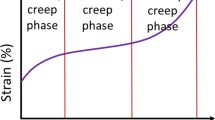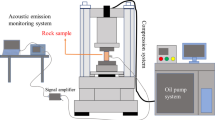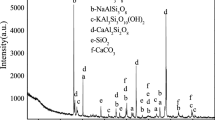Abstract
Coal mining activity disturbs the natural equilibrium of in situ stress state such that the induced stresses deform the surrounding rock mass. Although the installation of roof supports typically prevents rock deformation, rock mass failure may still occur in bolted roof. The erratic failure of rock mass after few days to months and years of excavation is the result of time-dependent deformation of roof rock under constant surrounding stresses. In the current research, the triaxial laboratory creep experiments proved that Marcellus shale exhibits time-dependent deformation under constant stress that was smaller than the failure strength. However, unlike conventional experimental results, the time-dependent deformation did not depend on the level of constant stress. The often-neglected initial state of specimens and intrinsic heterogeneity highly influenced the time-dependent failure of Marcellus shale.




source with sandstone specimen [23]








Similar content being viewed by others
Availability of Data and Material
All data used to support the findings of the current study are available from the corresponding author upon request.
Code Availability.
Not applicable.
References
ASTM D7012-14e1 (2014) Standard test methods for compressive strength and elastic moduli of intact rock core specimens under varying states of stress and temperatures. ASTM International, West Conshohocken, PA
ASTM D7070-16 (2016) Standard test methods for creep of rock core under constant stress and temperature. ASTM International, West Conshohocken, PA
Benmokrane B, Chekired M, Xu H (1995) Monitoring behavior of grouted anchors using vibrating-wire guages. J Geotechn Eng 121(6):466–475
Bieniawski ZT (1967) Mechanism of brittle fracture of rock: Part I - theory of the fracture process. Int J Rock Mech Min Sci Geomech Abstr 4(4): 395–404
Bosman JD, Malan DF, Drescher K (2000) Time-dependent tunnel deformation at Hartebeestfontein Mine. J South Afr Inst Min Metall 100(6):333–340
Cruden DM (1974) The static fatigue of brittle rock under uniaxial compression. Int J Rock Mech Min Sci 11:67–73
Dusseault MB, Fordham CJ (1993) Time-dependent behavior of rocks. In: JA Hudson (ed)Rock testing and site characterization, vol 3. Pergamon Press, pp 119–149
Griggs DW (1940) Experimental flow of rocks under conditions favoring recrystallization. Geol Soc Am Bull 51:1001–1022
Gupta N, Mishra B (2020) Experimental investigation of the influence of bedding planes and differential stress on microcracks propagation in shale using X-ray CT scan. Geotech Geol Eng. https://doi.org/10.1007/s10706-020-01487-z
Gupta N (2019) Fundamental mechanism of time dependent failure in shale. Dissertation, West Virginia University
Gupta N, Mishra B (2017) Creep characterization of Marcellus shale, Proceedings of 51st U.S. Rock Mechanics Symposium, San Fransisco, California, USA
Heap MJ (2009) Creep: Time-dependent brittle deformation in rocks. Dissertation, University College London
Hobbs DW (1970) Stress-strain-time behavior of a number of coal measure rocks. Int J Rock Mech Min Sci 7:149–170
Kranz RL (1980) The effect of confining pressure and stress difference on static fatigue of granite. J Geophys Res 85:1854–1866
Kranz RL, Scholz CH (1977) Critical dilatant volume of rocks at the onset of tertiary creep. J Geophys Res 82(30):4893–4898
Louviere A (2017) Roof fall accidents decline, but remain leading cause of coal miner injuries. https://www.msha.gov/news-media/press-releases/2017/07/06/roof-fall-accidents-decline-remain-leading-cause-coal-miner. Accessed 26 June 2021
Mishra B, Verma P (2015) Uniaxial and triaxial single and multistage creep tests on coal-measure shale rocks. Int J Coal Geol 137(1):55–65
Molinda GM, Klemetti T (2008) Diagnosing and controlling moisture-sensitive roof in coal mines. Electron J Geotech Eng 13(A):1–20
Nishihara M (1952) Creep of shale and sandy shale. J Geol Soc Japan 58:373–377
Peng SS (2008) Coal mine ground control, 3rd edn. Society for Mining Metallurgy, pp 750
Phillips DW (1931) Further investigation of the physical properties of coal measure rocks and experimental work on development of fractures. Trans Inst Min Eng 82:432–450
Price NJ (1964) A study of the time-strain behavior of coal measure rocks. Int J Rock Mech Min Sci 1:277–303
Rodriguez R, Crandall D, Song X et al (2014) Imaging techniques for analyzing shale pores and minerals. NETL Technical Laboratory Series, U.S. Department of Energy, National Energy Technology Laboratory, Morgantown, WV, pp 40
Scholz CH (1968) Microfracturing and the inelastic deformation of rock in compression. J Geophys Res 73(4):1417–1432
Singh DP (1975) A study of creep of rocks. Int J Rock Mech Min Sci Geomech Abstr 12:271–276
Song ZP, Yang TT, Jiang AN, Zhang DF, Jiang ZB (2016) Experimental investigation and numerical simulation of surrounding rock creep for deep mining tunnels. J South Afr Inst Min Metall 116(12):1181–1188
Tewalt SJ, Ruppert LF, Bragg LJ et al (2001) A digital resource model of the Upper Pennsylvanian Pittsburgh coal bed, Monogahela Group, northern Appalachian basin coal region. U.S. Geological Survey Professional Paper 1625-C, pp 102
Zhang Y, Xu WY, Shao JF, Zhao HB, Wang W (2015) Experimental investigation of creep behavior of clastic rock in Xiangjiaba Hydropower Project. Water Sci Eng 8(1):55–62
Zhao XG, Cai M (2010) A mobilized dilation angle model for rocks. Int J Rock Mech Min Sci 47:368–384
Acknowledgements
The authors would like to thank Sarah Brown, Johnathan E. Moore, and Bryan Tenant at the National Energy Technology Laboratory in Morgantown, WV, for the X-ray CT scan of shale specimens. The authors would also like to thank Dr. Karen Martin and Sarah McLaughin from Animal Models and Imaging Facility (AMIF) of West Virginia University (WVU) for providing access to Bruker CTAn software.
Funding
Financial support for this work was provided by the Centers for Disease Control and Prevention-National Institute of Occupational Safety and Health (No. 200–2016-92214).
Author information
Authors and Affiliations
Corresponding author
Ethics declarations
Competing Interests
The authors declare no competing interests.
Additional information
Publisher's Note
Springer Nature remains neutral with regard to jurisdictional claims in published maps and institutional affiliations.
Rights and permissions
About this article
Cite this article
Gupta, N., Mishra, B. Experimental Investigation of Time-Dependent Deformation in Brittle Marcellus Shale. Mining, Metallurgy & Exploration 38, 1943–1953 (2021). https://doi.org/10.1007/s42461-021-00462-3
Received:
Accepted:
Published:
Issue Date:
DOI: https://doi.org/10.1007/s42461-021-00462-3




